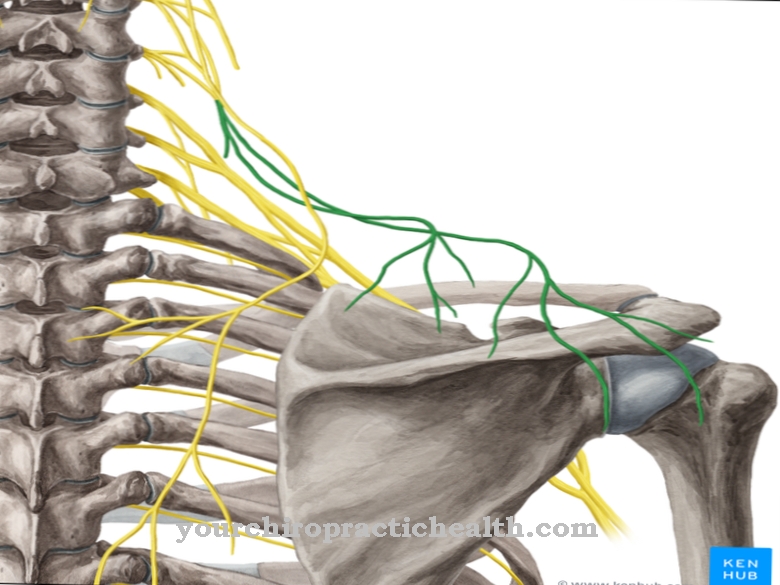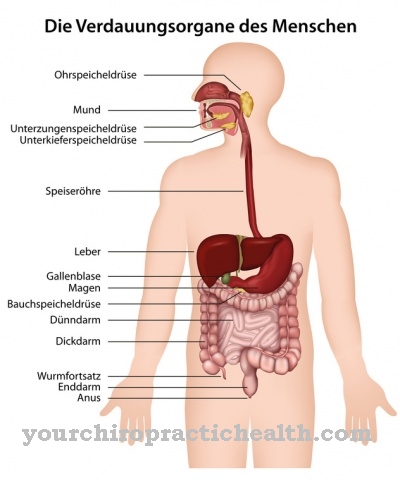At the bottom of the pelvic cavity is the muscular one constructed from connective tissue pelvic floor. The pelvic floor is known for the pelvic floor weakness that often occurs in women.
What is the pelvic floor?
Of the pelvic floor is the floor of the pelvic cavity in humans, which consists of connective tissue and muscles. Among other things, the pelvic floor is formed by the so-called "levator ani muscle" (lifter of the anus).
In quadruped mammals, the term pelvic floor refers to the area of the ventral surface between the pubic and ischial bones in the bony pelvis due to the posture and position of the pelvis.
In humans, the rear end of the pelvic cavity is referred to as the so-called retroperitoneal part of the pelvic cavity.
Anatomy & structure
Of the pelvic floor is divided into three parts: the pelvic diaphragm, the urogenital diaphragm and the sphincter and cavernous body layer.
The pelvic diaphragm is the back part of the pelvic floor, the urogenital diaphragm is the front part of the pelvic floor. These are muscle plates, the mechanical center of the pelvic floor is the centrum tendineum, which is a sinewy connection.
The pelvic diaphragm forms the inner muscle layer of the pelvic floor, which is used to close or lift the anus. The urogenital diaphragm is a 1 cm thick plate consisting of muscles and connective tissue, which lies between the lower branches of the pubis (pubic bone) and the ischial tuberosity (ischial tuberosity).
Function & tasks
The three main functions of the Pelvic floor consist of tension, relaxation and reflex counter-holding (tension as a possible reaction to an increase in pressure in the abdomen).
Both women and men use tension to secure continence. The muscles of the pelvic floor support the lower part of the urethra and the sphincter muscles of the urinary bladder and anus. The relaxation of the pelvic floor occurs, among other things, when defecating, when urinating and in both men and women during sexual intercourse.
During orgasm, the pulsation of the pelvic floor causes a change between tension and relaxation. A reflex counter-holding by the pelvic floor usually occurs when sneezing and coughing, when laughing, jumping and when carrying heavy loads. If reflex counter-resistance is not possible, then there is usually a loss of urine.
Illnesses, ailments & disorders
Of the pelvic floor is - regardless of gender - usually weakened by being overweight, by chronic physical overload, by poor posture, by operations in the small pelvis or sometimes by taking certain medications.
The muscles of the pelvic floor are also weakened in women through pregnancy and childbirth. As a rule, there is then a lack of control of the excretory organs, in the worst case even bladder subsidence, vaginal prolapse or uterine subsidence. However, these weaknesses can be remedied through appropriate retrograde training. There are special exercises that help develop and control the muscles of the pelvic floor in women and also help women to better control their orgasm.
Women who tense the muscles of their pelvic floor or the vagina reflexively or permanently, have what is known as a vaginal spasm or vaginismus. It is usually not possible for these women to relax the corresponding muscles during a gynecological examination or during sexual intercourse in such a way that a painless penetration of the speculum or penis is possible.
A so-called hernia (intestinal hernia, in which the intestines emerge from the abdominal cavity through a congenital or acquired gap) in the area of the pelvic floor with a possible perineum protrusion (perineum) is a perineal hernia in the medical field. This disease rarely occurs in humans, but is common in male domestic dogs that have not been neutered.
In the case of a perineal hernia, there is usually a break between the external sphincter ani muscle (opening of the intestine) and the levator ani muscle (lifter of the anus) or between the levator ani muscle and the coccygeus muscle (muscle of the tailbone).
A healthy body weight should be ensured as a preventive measure against damage to the muscles of the pelvic floor. In addition, it makes sense to aim for good posture and also to avoid heavy physical strain. After pregnancy and childbirth, women should definitely take part in a postnatal gymnastics course in order to avoid later consequences as far as possible.
You can find your medication here
➔ Medicines for bladder and urinary tract health

























.jpg)


